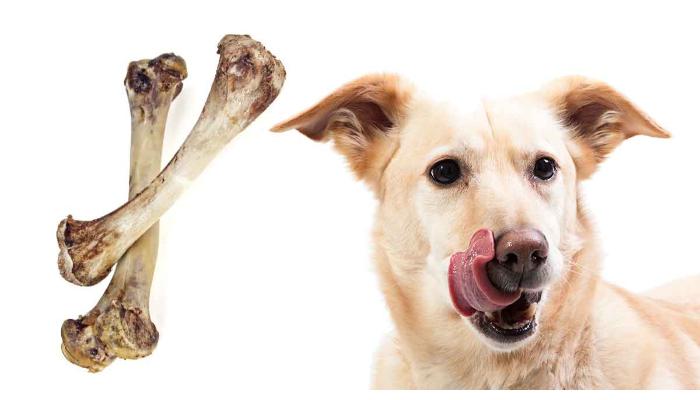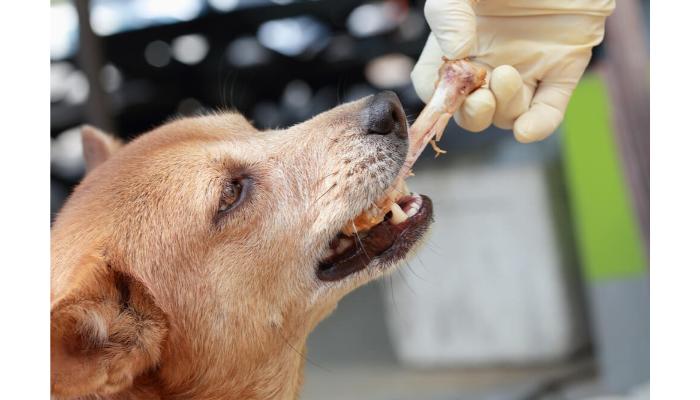You’ve just finished dinner, eyeing the chicken bones on your plate, and there’s your dog—gazing up with those big, pleading eyes.
But wait, before you toss a bone their way, let’s delve into the facts. Are chicken bones a treat or a threat to your furry friend?
This article unpacks the risks, demystifies common myths, and explores safe alternatives to keep your pooch happy and healthy without compromising their safety.
Let’s chew over the evidence together.
Understanding the Basics of Dog Digestion:

To grasp why chicken bones can be hazardous for your dog, it’s essential to understand how their digestive system processes food. Dogs have evolved with canine teeth designed for tearing meat rather than grinding hard substances like bones. When your dog chews on chicken bones, they can splinter and cause choking or severe damage to the gastrointestinal tract.
Digestive enzymes in dogs are robust, allowing them to break down proteins and fats efficiently. However, sharp bone fragments can resist quick digestion and may puncture the digestive lining, leading to potential emergencies. While their stomach acidity is high, it’s not always effective against bone splinters.
Thus, feeding your dog chicken bones risks their health, as their digestive system isn’t adapted to safely process these hard, brittle items.
Risks of Feeding Chickens Bones to Dogs:
While you might think giving your dog chicken bones is a tasty treat, it’s important to be aware of the risks they pose to your pet’s health. Cooked chicken bones can easily break and form sharp edges, creating a severe choking hazard. If ingested, bone splinters can also cause significant damage to your dog’s digestive tract, leading to costly and stressful emergency veterinary visits. The splinters may puncture the stomach or intestines, causing internal bleeding, infections, or blockages that might require surgical intervention.
It’s crucial to be cautious and avoid offering any type of cooked bones, including those from chicken, as they’re more brittle and likely to splinter compared to their raw counterparts. Always prioritize your dog’s safety by choosing safe, vet-recommended chew treats.
Safe Alternatives to Bone Treats for Dogs:
Instead of risking your dog’s health with chicken bones, consider safer chewing alternatives that can satisfy their need to gnaw without the dangers. These alternatives provide not only chewing stimulation but also nutritional enrichment, ensuring that your dog enjoys both mental and physical benefits.
| Safe Chew Options | Benefits |
|---|---|
| Veterinary-Approved Dental Chews | Designed to clean teeth and freshen breath |
| Natural Bully Sticks | Fully digestible and high in protein |
| Rubber or Nylon Chew Toys | Durable and can massage gums |
| Rawhide Alternatives (like fish skins) | Offer a safer, digestible option |
Choose options that are appropriate for your dog’s size and chewing habits. Always supervise your dog with any new chew to ensure they’re safe and to prevent any choking hazards or digestive issues.
Myths Versus Facts:

You’ve learned about safe chew options for your dog, but let’s debunk some myths and confirm the facts about feeding them chicken bones.
A common misconception is that dogs can safely digest all types of bones due to their strong digestive enzymes. However, the fact is that the bone composition of cooked chicken bones can be dangerous. Cooking alters the structure, making them brittle and prone to splintering. These splinters can cause choking, intestinal blockages, or even perforate your dog’s digestive tract.
While dogs do possess powerful digestive enzymes, these aren’t designed to safely break down sharp, fragmented bones. It’s crucial to stick to the evidence and avoid risking your pet’s health on widely-held but inaccurate beliefs about feeding chicken bones to dogs.
Preventing Bone-Related Injuries:
To safeguard your dog from bone-related injuries, it’s essential to keep them away from chicken bones, especially after cooking. Cooked bones become brittle and are prone to bone splintering, which can cause grave injuries or even be fatal for your pet. These fragments can puncture your dog’s digestive tract or cause intestinal blockages that require emergency veterinary care.
Moreover, whole bones pose choking hazards, particularly for voracious eaters who might attempt to swallow them whole. Always supervise your dog’s chewing activities and provide appropriate chew toys that satisfy their gnawing instincts without endangering their health.
Frequently Asked Questions:
Your dog’s breed digestion traits and size consideration are crucial factors in safely ingesting bones. Smaller breeds may choke easily, while larger ones might handle them better, but risks always exist.
Wading into a sea of bone density and nutritional considerations, you’ll find that wing bones, being smaller and more brittle, pose a greater risk to dogs than the denser thigh bones.
Cooking methods significantly affect bone fragility; boiled bones may be softer, but they’re still risky. Grilling can cause splintering, increasing the hazard for your dog. Always prioritize safety when feeding bones.
You should watch for vomiting, bloody stools, or abdominal pain, as these symptoms may indicate bone obstruction or digestive perforation if your dog has ingested a chicken bone. Contact your vet immediately.
If you suspect your dog has ingested bone fragments, don’t wait for symptoms. Seek immediate veterinary consultation to prevent potential internal harm, ensuring your pet’s safety with professional, evidence-based care.
Conclusion:
In conclusion, while it’s tempting to toss your pup a chicken bone, the risks are real and the stakes high. Coincidentally, the very day you consider it might be the day an emergency vet visit becomes necessary. Stick with safer chews designed for dogs to prevent harm.
Myths can’t trump fact; chicken bones can splinter and cause serious injury. Protect your furry friend with knowledge and care, ensuring their tail-wagging days are both happy and healthy.

Hey there, I’m Janet Brooks, a dog-loving student from California. I’m all about helping pups in need, especially those without homes. Me and my awesome friends work together to give shelter and love to stray dogs. Oh, and I also write blogs about dogs to share helpful info.